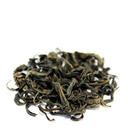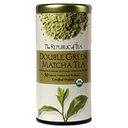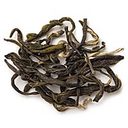Ha Dong Bohea Green Tea
This tea has been retired/discontinued.
 |
|
Commercial Description
This rare green tea undergoes two fermentation cycles and is dried in a traditional Korean clay pot to give it a unique, earthy quality. The resulting flavor is sweet and smooth.
Brewing Instructions: (from Republic of Tea)
1.5 tsp per 6 oz. water, 3 min, 180°F
Ratings & Reviews
Page 1 of 1 page with 2 reviews
 87 Aroma: 9/10 Flavor: 5/5 Value: 4/5
87 Aroma: 9/10 Flavor: 5/5 Value: 4/5Kelsey (142 reviews) on Sep. 24th, 2013
This is one of the most complex and unusual teas I've ever tried -- I loved it!
I was especially surprised by this tea's taste, since I'm accustomed to my green teas being subtly flavored. The taste was an unexpected blend of cooked vegetables and toasty tones, reminding me of asparagus paired with pea soup,,, which is really yummy in my book. This tea was a meal in itself!
Awesome job Republic of Tea -- keep up the good work. :)
 92 Aroma: 10/10 Flavor: 5/5 Value: 4/5
92 Aroma: 10/10 Flavor: 5/5 Value: 4/5Alex Zorach (1453 reviews) on Aug. 12th, 2013
I thought this tea to be delightful and very different. It was not really at all like a typical green tea...much more like a green Taiwanese oolong, and in some ways almost suggestive of some aged Pu-erh.
Dry leaf has a most peculiar aroma: highly vegetal and slightly nutty, perhaps fruity too.
Upon brewing, the aroma becomes much more vegetal and seaweedy, like a tidepool near the ocean. More seaweedy than any Japanese tea I've tried, but there are also tones of honey and mushrooms. The aroma profile is actually very similar to some Korean foods I've had, especially stir-fried mushrooms and seaweed. The steeped leaves turn quite dark brown, and produce a tan to light brown cup.
When brewing with hotter water (which I prefer) woody, floral, and honey tones dominate, and the overall character becomes more oolong-like.
Extremely mild flavor, with significant sweetness, and when brewed more strongly, a buttery-smooth mouthfeel suggestive of a top-quality Taiwanese oolong.
Upon sipping more, there are some slightly toasty, oolong-like tones, giving way to a very clean finish.
I found that I liked brewing this with much hotter temperature water than recommended--at least 190 but I think this tea can take boiling water just fine. With cooler water, it is not only bland but has a very watery feel. The first time I brewed it, it was aromatic yet vanished off my palate almost like drinking pure water. The higher water temperature results in a stronger flavor and a much richer, more full-bodied cup.
Able to brew two infusions, but I prefer longer steepings, and brewed this way, the second infusion was less flavorful and it was hard to get a third out of it. This tea may taste oolong-like but it infuses much faster than its large, intact leaves would suggest. I suspect with briefer steepings this tea would make many cups but I did not like the results produced this way--they were less complex.
This is a high-end tea but I think the price is reasonable given the quality: it's $12 for 50 grams, but the leaf goes pretty far, and the leaves are completely unbroken. Seems on par with many high-quality green oolongs in this price range, minus the fact that it doesn't perform quite as well at multiple steepings.
Page 1 of 1 page with 2 reviews





